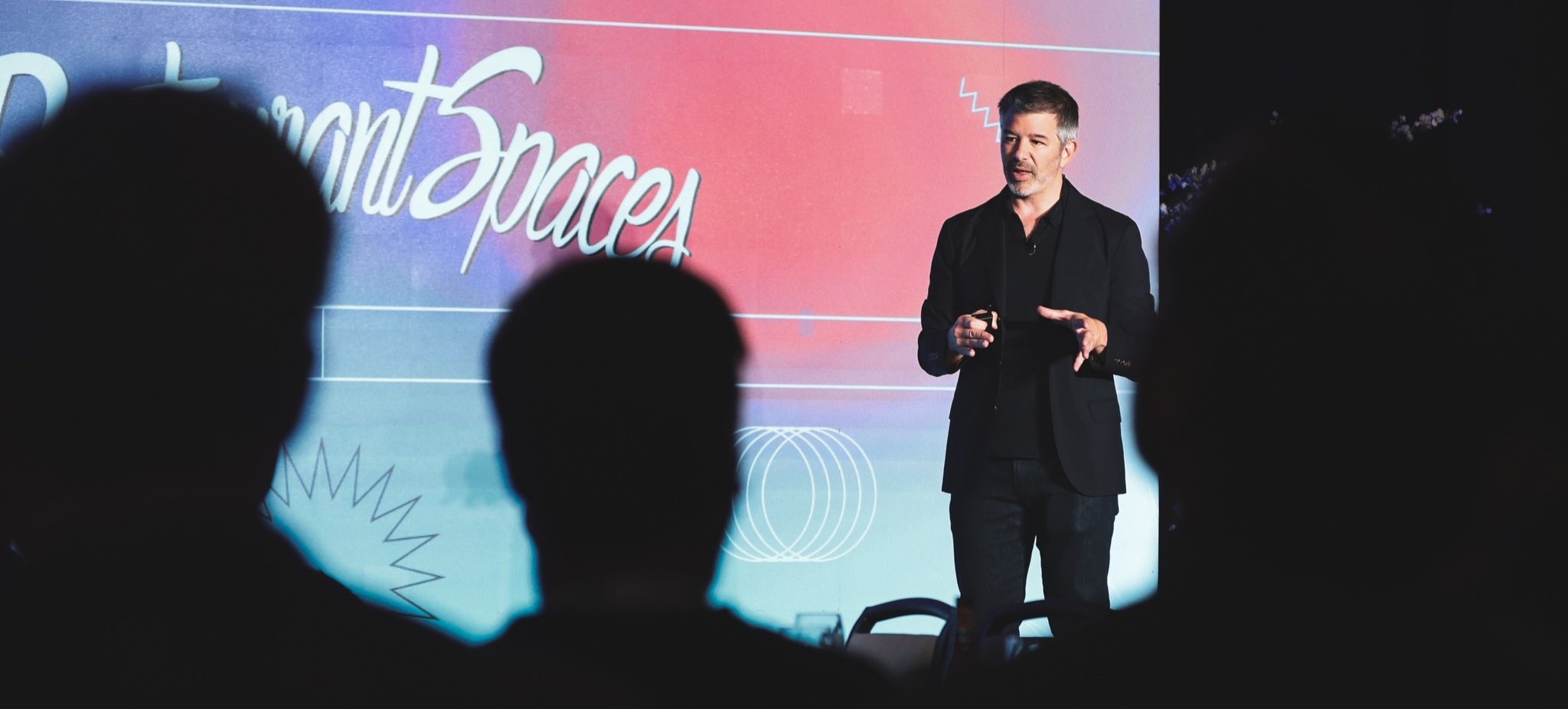
Uber founder Travis Kalanick has laid pretty low since leaving the game-changing rideshare company in 2017. But that isn’t to say he disappeared from the public eye entirely. Indeed, he became CEO of City Storage Systems (CSS) less than a year later, investing heavily in its subsidiary CloudKitchens. In addition to the ghost kitchen operator, CSS’s portfolio also includes the restaurant robotics company Lab37 and the restaurant software provider Otter.
Kalanick has largely operated in “stealth mode” since entering the restaurant business, declining public speaking opportunities until last month — when he delivered a keynote presentation at RestaurantSpaces in Los Angeles, his first speaking engagement in seven years.
Why make a return now? As much as he prefers to stay under the radar (and out of the news cycle), Kalanick also understands that making in-person connections is an essential part of innovation.
“If you want to inspire folks, you can’t just sit in a cave all day,” he said. “You have to get out and talk to folks and show them what you’re up to. You have to connect with them human-to-human. That’s what this is about.”
His appearance at RestaurantSpaces was also the perfect opportunity to outline his vision to revolutionize our access to food.
 Travis Kalanick speaking at RestaurantSpaces in April '24
Travis Kalanick speaking at RestaurantSpaces in April '24
Kalanick didn’t get into the food service business to transform the experience of eating at restaurants. He’s after something much grander than that: for all the industry’s growth over the past few decades, he argued, restaurants still haven’t come anywhere close to beating their biggest competitor.
“There’s one place that’s the hands-down winner of meals, and it’s called the home,” he said. “If the price of a meal prepared and delivered to you started to approach the cost of going to the grocery store, could you do to the kitchen what Uber did to the car?”
In other words, he’s not gearing up to disrupt just restaurants, but also the $1.3 trillion grocery market. For Kalanick, transforming the way people eat is just like everything else: a matter of increasing efficiencies, which will bring down costs in turn.
“People are willing to pay so much for convenience, it could be that you actually double the value that people get out of it,” he said. “It's a huge opportunity. We've got to get costs down, we've got to give people convenience and their time back.”
With this in mind, Kalanick’s overarching vision for the industry is what he refers to as the internet food court: a service that allows users to order whatever meal they want, with lightning-fast delivery.
The linchpin of the internet food court is the titular cloud (or ghost) kitchen, or what Kalanick’s team calls a multi-tenant food manufacturing facility. Utilizing a dedicated production center for off-premise delivery is a strategy many restaurant chains have flirted with for several years now, for obvious reasons. It has the potential to reduce overhead and real estate costs while allowing brands to ramp up delivery operations, without affecting operations at existing customer-facing locations.
 A CloudKitchens location in Dallas
A CloudKitchens location in Dallas
Kalanick described a few potential use cases for cloud kitchens. A big one is whitespace expansion, especially when it comes to crowded, costly real estate markets. A dedicated off-premise business can give brands the power to penetrate previously inaccessible neighborhoods and cities.
Then there’s the freedom it gives brick-and-mortar locations, which often find themselves so overwhelmed by delivery orders that they have to turn the channel off entirely. A cloud kitchen allows them to offload those orders and focus on their dine-in business without sacrificing off-premise revenue.
“What we found in those situations is that the revenue from walk-in traffic goes up,” Kalanick explained. “Because when lots of couriers are coming in and the complexity of everything starts to curve, you're trading offline orders for online orders. And when you get those online orders off-loaded, the brick and mortar revenue starts to buoy back up to where it was.”
If ghost kitchens are the linchpin of the internet food court, then robotics are the linchpin of the ghost kitchen.
In Kalanick’s vision, the multi-tenant food manufacturing facility slashes labor costs and boosts efficiency through automated production. Lab37’s “bowl builder” robot, for instance, can make and bag more than 100 bowls per hour: all that’s required of a human employee is placing ingredients in the machine.
“It takes out 50 percent of the labor on a bowl-type concept,” Kalanick said. “Eighteen food dispensers, 10 sauce choices, everything's thermally controlled. This robot is already running a $2 million AUV restaurant in Pittsburgh, right now, delivery only.”

Lab37's autonomous Bowl Builder technology
Kalanick expects it will be some time before this sort of technology is the norm — perhaps as long as ten years. One hurdle is that it’s not just about building the robot: it’s about building the robot that builds the robots.
“It just takes a certain amount of time to get the meta machine up and running so that you can produce hundreds or thousands of these robots per year,” he said. Once the kinks are worked out, though, he predicts these machines will quickly become modular, capable of making not only bowls but whatever a particular restaurant demands.
Kalanick’s vision around automation doesn’t stop at production. As brands and consumers alike know all too well, one of the biggest expenses in food delivery is delivery itself. The key to reducing this expense, he argued, is automating logistics with delivery robots and drones… even if it could take a while for that scenario to eventuate.
“It’s all about the catapult,” he joked. “You just have this central facility with catapults and you shoot the food wherever it needs to go.”
Jokes aside, Kalanick believes autonomous vehicles are an inevitability, despite how long it’s taken so far to develop the technology. Referring to progress made by Tesla and Waymo, he explained once manufacturers have figured out a way of churning out full self-driving vehicles at scale, things will get interesting.

Kalanick also stressed the cloud kitchen model's positive environmental impacts, in addition to its benefits for brands and consumers. When companies slash their construction and materials costs (while using more efficient delivery methods), they also slash their energy bills, reducing emissions across the industry.
“Everything about what we do is about efficiency,” he concluded. “When that efficiency plays out, restaurants win — but the environment wins too.”

Posted by
A One of a Kind Retreat for Hotel Development, Design & Construction Leaders.
Oct 25-27, 2026 | Fort Lauderdale, FL
Learn more
© Copyright 2025 influence group. All Rights Reserved
Comments